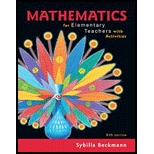
Concept explainers
Ted thinks that because
a. by drawing an array
b. by writing equations that use the distributive property
Learn your wayIncludes step-by-step video

Chapter 4 Solutions
Mathematics for Elementary Teachers with Activities (5th Edition)
Additional Math Textbook Solutions
Calculus for Business, Economics, Life Sciences, and Social Sciences (14th Edition)
Pre-Algebra Student Edition
Calculus: Early Transcendentals (2nd Edition)
College Algebra (7th Edition)
Elementary Statistics: Picturing the World (7th Edition)
Elementary Statistics
- Use Heun's method to numerically integrate dy dx = -2x3 +12x² - 20x+8.5 from x=0 to x=4 with a step size of 0.5. The initial condition at x=0 is y=1. Recall that the exact solution is given by y = -0.5x + 4x³- 10x² + 8.5x+1arrow_forwardB: Study the stability of critical points of ODES: *+(x²-2x²-1)x+x=0 and draw the phase portrait.arrow_forwardB: Study the stability of critical points of ODEs: -2x²+x²+x-2=0 and draw the phase portrait.arrow_forward
- 2/ Draw the phase portrait and determine the stability of critical point: ✗ 00 +2X°-x²+1=0arrow_forwardstudy the stability of critical point of oDES: 2 200+ (x² - 2x² - 1) + x=0 and draw the phase portrait.arrow_forwardQ/study the stability of critical point and draw the phase portrait:- to -x-x³ x = 0arrow_forward
 Algebra: Structure And Method, Book 1AlgebraISBN:9780395977224Author:Richard G. Brown, Mary P. Dolciani, Robert H. Sorgenfrey, William L. ColePublisher:McDougal Littell
Algebra: Structure And Method, Book 1AlgebraISBN:9780395977224Author:Richard G. Brown, Mary P. Dolciani, Robert H. Sorgenfrey, William L. ColePublisher:McDougal Littell Holt Mcdougal Larson Pre-algebra: Student Edition...AlgebraISBN:9780547587776Author:HOLT MCDOUGALPublisher:HOLT MCDOUGAL
Holt Mcdougal Larson Pre-algebra: Student Edition...AlgebraISBN:9780547587776Author:HOLT MCDOUGALPublisher:HOLT MCDOUGAL
 Elementary AlgebraAlgebraISBN:9780998625713Author:Lynn Marecek, MaryAnne Anthony-SmithPublisher:OpenStax - Rice University
Elementary AlgebraAlgebraISBN:9780998625713Author:Lynn Marecek, MaryAnne Anthony-SmithPublisher:OpenStax - Rice University
 Glencoe Algebra 1, Student Edition, 9780079039897...AlgebraISBN:9780079039897Author:CarterPublisher:McGraw Hill
Glencoe Algebra 1, Student Edition, 9780079039897...AlgebraISBN:9780079039897Author:CarterPublisher:McGraw Hill





